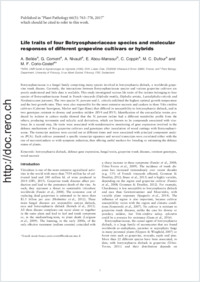Life traits of four Botryosphaeriaceae species and molecular responses of different grapevine cultivars or hybrids
- Bellée, A. INRA, UMR Santé et Agroécologie du Vignoble, Villenave d'Ornon, France
- Comont, G. INRA, UMR Santé et Agroécologie du Vignoble, Villenave d'Ornon, France
- Nivault, A. INRA, UMR Santé et Agroécologie du Vignoble, Villenave d'Ornon, France
- Abou-Mansour, Eliane Plant Biology Department, University of Fribourg, Switzerland
- Coppin, C. INRA, UMR Santé et Agroécologie du Vignoble, Villenave d'Ornon, France
- Dufour, M. C. INRA, UMR Santé et Agroécologie du Vignoble, Villenave d'Ornon, France
- Corio-Costet, M. F. INRA, UMR Santé et Agroécologie du Vignoble, Villenave d'Ornon, France
-
01.06.2017
Published in:
- Plant Pathology. - 2017, vol. 66, no. 5, p. 763–776
botryosphaeria dieback
defence gene expression
fungal toxin
grapevine trunk diseases
resistant genotypes
wood necrosis
English
Botryosphaeriaceae is a fungal family comprising many species involved in botryosphaeria dieback, a worldwide grapevine trunk disease. Currently, the interactions between Botryosphaeriaceae species and various grapevine cultivars are poorly understood and little data is available. This study investigated various life traits of five isolates belonging to four species of Botryosphaeriaceae found in French vineyards (Diplodia mutila, Diplodia seriata, Lasiodiplodia viticola and Neofusicoccum parvum). The two species N. parvum and L. viticola exhibited the highest optimal growth temperature and the best growth rates. They were also responsible for the most extensive necrosis and cankers in three Vitis vinifera cultivars (Cabernet Sauvignon, Merlot and Ugni-Blanc) that differed in susceptibility to botryosphaeria dieback, and in two genotypes resistant to downy and powdery mildew (RV4 and RV5). Identification of the extracellular toxins produced by isolates in culture media showed that the N. parvum isolate had a different metabolite profile from the others, producing terremutin and salicylic acid derivatives, which are known to be compounds associated with virulence. In a second step, life traits were associated with nondestructive monitoring of gene expression involved in the defence mechanisms of five grapevine cultivars and genotypes after inoculation of wood cuttings with Botryosphaeriaceae. The transcript analyses were carried out at different times and were associated with principal component analysis (PCA). Each cultivar presented a specific transcript signature and several transcripts were correlated either with the size of necrosis/cankers or with symptom reduction, thus offering useful markers for breeding or estimating the defence status of plants.
- Faculty
- Faculté des sciences et de médecine
- Department
- Département de Biologie
- Language
-
- English
- Classification
- Biological sciences
- License
-
License undefined
- Identifiers
-
- RERO DOC 305026
- DOI 10.1111/ppa.12623
- Persistent URL
- https://folia.unifr.ch/unifr/documents/305882
Other files
Statistics
Document views: 121
File downloads:
- pdf: 275
- Supplementary material: 140

